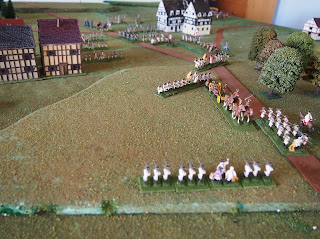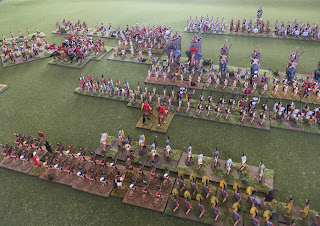The Action at Pretzsch is a little-known rearguard action involving an Austrian retreat (how unusual for this period?) under strong pressure from advancing Prussians. A brief summary from the excellent Kronoskaf website Project SYW describes the action thus;
"On October 29 in the morning, Arenberg quitted his positions to march to Wittenberg. When the Prussians heard of his departure, Finck marched immediately to follow Arenberg's Corps. When Wunsch reached Gemmingen's post at the defile of Merckwitz (unidentified location), Arenberg retired precipitously on Düben through the forest of Torgau, closely followed by Gemmingen. The latter sent Colonel Haller at the head of his vanguard (2 000 men) on the heights of the Sackwitz wood to cover his retreat. Haller's detachment had not yet reached the summit when Jung Platen Dragoons along with Prussian hussars appeared on the crest. The Prussian cavalry immediately charged the Austrian grenadiers and drove them back, capturing Gemmingen along with 1 400 men. Wunsch and Rebentisch then encamped at Meuro."Our game of this action, based on the scenario in Charles S. Grant's Refighting History Volume 1, involved General Gemmingen trying to extract his troops from heights behind Sackwitz and across a bridge at Reinharz with Wunsch's Prussians hard on his heels.
This is a combined report of both games.
Version 1, Age of Reason
As I came in late, the report of the first version is somewhat abbreviated.
When I took over the Austrians, they had made good headway to the bridge, with Prussians close at their heels.
I sent the Serbollini cuirassiers and Jung Modena dragoons (heavily disguised as Saxe-Gotha) to drive the Prussian hussars away from the Austrian left. This was greatly successful, capturing the Prussian brigade commander in the process!
As Gemmingen's men fought for their lives, Arenberg's column proceeded to retreat unmolested.
With only a few units safely over the bridge, accumulated losses meant that the Austrians failed their 'army' withdrawal test and would retreat.
Game 1 over. Prussian victory.
Version 2, Zimmermann
We re-set the table to the original starting positions. Sackwitz can be seen in the distance, with the heights this side of the town. The bridge is in the left foreground. Gemmingen's Austrians are deployed in and around Sackwitz with the heights at their back. The Prussians are coming on from the far table edge. Arenberg's column can be seen at the right of the photo.
This time we began with some aggressive cavalry action, the Austrian dragoons and cuirassiers again seeing off the Prussian hussars, bloodied but not beaten.
As the Prussian infantry advance, the Austrians 'head for the hills', leaving sacrificial grenadiers to protect their rear.
Early on it was looking good for the Austrians (apart from the last grenadier battalion). "This is gonna be a walk in the park, I thought!"
Arenberg's lead battalions neared the table edge and exited to safety.
On my left the Austrian cavalry were conducting a model withdrawal?
Gemmingen's first infantry unit safely over the bridge. "This is *easy*, I thought."
Still looking good with nearly three units over the bridge and one about to exit to safety.
Time for the cavalry to join them, I thought.
Looks like another unit of grenadiers will have to be lost for the greater good!
The foolishness of my version of the 'Julian manoeuvre' was now made glaringly apparent to me as the lead, fresh unit of Prussian hussars took the Jung Modena dragoons in the rear, driving them headlong towards the bridge, bringing chaos and confusion!
Still blissfully ignorant of this (or not caring) Arenberg's last units make their safe exit.
The Jung Modena dragoons have reformed, as have the Serbollini cuirassiers at top left (now much reduced in numbers). The rear units of Austrian infantry joining them as an ad hoc rearguard.
The Prussians have reached the edge of the heights, more Prussian cavalry are coming down the right of the woods.
The Jung Modena dragoons selflessly sacrificed themselves to enable the guns to get over the bridge and away.
The escapees: Gemmidgen's much reduced force.
The Austrians had been a bit more successful in extracting troops the second time around, but lost all the cavalry and grenadiers in the process!
Game 2 over. Prussian minor victory due to those significant losses which were similar to the historical version (without the loss of Gemmingen).
This was a fantastic scenario. As the Austrian player I initially thought it was going well and easily, but the Prussians soon caught up and there was pressure galore to try to extricate troops while putting up a delaying defence.
Plenty of pressure for the Prussians too, trying to rush headlong at the Austrians while maintaining a viable attack formation.
An excellent scenario. Thanks Charles! Thanks Mark for providing such wonderful figures to fight it with and to Julian for the venue (ANF-HQ)!





























































